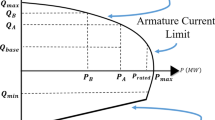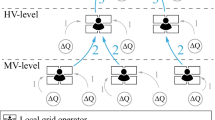Abstract
Reactive power market is usually held as independent from energy and reserved active power markets; however, active and reactive power are in close relation due to a variety of mediums such as load flow equations, current limitations on the network lines, and synchronous generator capacity curve. Therefore, reactive power market conditions can affect active and reactive power markets. A new structure for joint energy and reactive power market (JERPM) is proposed in this article to resolve the difficulties pertaining interactions between active and reactive power markets. Holding a new market called joint active and reactive power reserved market (JARPRM) is proposed afterwards. Some revisions have been made in lost opportunity cost calculations in JERPM, and availability cost payment is also omitted from the model here. The objective function of JARPRM market is to minimize the costs of simultaneous active and reactive power production, and the costs of energy not supplied. This market is run using voltage stability constraints for all possible contingency incidents. The level of reserved power required by the system is determined accordingly. The proposed market model is simulated on a 24-bus IEEE-RTS network and the results are compared to traditional independent markets.

Similar content being viewed by others
Abbreviations
- i, k :
-
Index for buses
- u :
-
Index for unit generators
- j :
-
Contingency index
- s :
-
Index for loads
- N :
-
Total number of buses
- NB:
-
Total number of buses which have generators
- NU i :
-
Total number of units connected to ith bus
- NL:
-
Total number of buses which have loads
- M:
-
Total number of contingency incidents
- (i,u):
-
uth unit generator connected to ith bus
- a i :
-
Price factor proposed by generator for being available
- m 1i :
-
Price factor proposed by generator for implementation in under excitation mode (absorbed reactive power)
- m 2i :
-
Price factor of incurred losses in coil, proposed by generator for implementation in (Q base, Q A) zone
- m 3i :
-
Price factor of lost opportunity, proposed by generator for implementation in (Q A, Q B) zone
- ρ p(i, u) :
-
Marginal cost proposed for producing active power
- \({\hat{\rho}_{p(i, u)}}\) :
-
Price proposed for active power production availability
- \({\hat{\rho}_{q1(i, u)}}\) :
-
Prices proposed for being available to absorb reactive power in zones (0 to Q Min)
- \({\hat{\rho}_{q2(i,u)}}\) :
-
Prices proposed for being available to produce reactive power in zones (Q A to Q base)
- VOLL k :
-
Value of lost load for the loads on bus K
- Y ik :
-
Admittance between buses i and k
- \({\delta _{ik}}\) :
-
Angle of admittance between buses i and k
- P is :
-
Active power consumed by loads connected to ith bus
- Q is :
-
Reactive power consumed by loads connected to ith bus
- X S(i,u):
-
Synchronous reactance
- VSMDesired :
-
Minimum desired value for VSM index at contingency incidents
- \({\rho _{p( {\rm MCP})}^{\rm sep}}\) :
-
Higher accepted price for active power production in separate active power market
- \({\rho _{p( {\rm MCP})}^{\rm sim}}\) :
-
Higher accepted price for active power production in JERPM
- P G(i,u) :
-
Active power produced
- \({P_{{\rm G}( {i,u})}^{\rm sep}}\) :
-
Active power produced in separate active power market
- \({P_{{\rm G}( {i,u})}^{\rm sim}}\) :
-
Active power produced in JERPM
- ρ q0 :
-
Higher accepted price for reactive power availability in separate reactive power market
- ρ q1 :
-
Higher accepted price for reactive power absorption in zones of (0 to Q Min) in separate reactive power market
- ρ q2 :
-
Higher accepted price for reactive power production in zones of (Q A to Q base)in separate reactive power market
- ρ q3 :
-
Higher accepted price for reactive power production in zones of (Q B to Q A) in separate reactive power market
- Q 1(i,u) :
-
Reactive power absorbed in zones of (0 to Q Min)
- Q 2(i,u) :
-
Reactive power produced in zones of (Q A to Q base)
- Q 3(i,u) :
-
Reactive power produced in zones of (Q B to Q A)
- W 0(i,u) :
-
Binary variable which state the uth unit is selected for production or being on standby in separate reactive market
- W 1(i,u) :
-
Binary variable which state the uth unit is working inside zones of (0 to Q Min)
- W 2(i,u) :
-
Binary variable which state the uth unit is working inside zones of (Q A to Q base)
- W 3(i,u) :
-
Binary variable which state the uth unit is working inside zones of (Q B to Q A)
- \({{\rm RP}_{G(i,u)}^{j}}\) :
-
Active power reserve required to produce by uth unit at jth contingency incident
- RP(i,u) :
-
Maximum required active power reserved capacity to produce by uth unit connected to ith bus
- \({{\rm RP}_{(i,u)}^{\rm max}}\) :
-
Active reserved amount determined in independent reserved active power market
- \({{\rm RQ}_{1(i,u)}^j }\) :
-
Reactive power reserve required to absorb by uth unit at jth contingency incident
- \({{\rm RQ}_{2(i,u)}^j}\) :
-
Reactive power reserve required to produce by uth unit at jth contingency incident
- RQ1(i,u) :
-
Maximum required reactive power reserved capacity to absorb by uth unit connected to ith bus
- RQ2(i,u) :
-
Maximum required reactive power reserved capacity to produce by uth unit connected to ith bus
- \({{\rm ENS}_k^j}\) :
-
Energy not supplied for bus k at contingency incident jth
- U i :
-
Voltage for bus i
- \({\theta _{i}}\) :
-
Angle of voltage for bus i
- S (i,k ):
-
Apparent power through the line between buses i and k
- Z (i,u) :
-
Binary variable which states the uth unit connected to ith bus is selected for production active power
- I a(i,u) :
-
Armature persistent mode current
- E f(i,u) :
-
Exciting voltage
- EPF i :
-
Expected payment function for generator connected to ith bus
- TRC:
-
Total reactive power production cost in separate reactive power market
- LOC i,u :
-
Lost opportunity cost
References
Prada, R.B.; Velasco, C.J.; da Silva, L.X.; de Melo, A.C.G.: Possible design of the brazilian ancillary service market for generation reserves. IEEE Power Syst. Manag. Control. 15, 414–419 (2002)
Motamedi, A.; Fotuhi-Firuzabad, M.: Ancillary service markets. IEEE Power Engineering, 2007 Large Engineering Systems Conference, pp. 316–320 (2007)
Danai, B.; Kim, J.; Cohen, A.I.; Brandwajn, V.; Show-Kang C.: Scheduling energy and ancillary service in the new Ontario electricity market. Innovative Computing for Power-Electric Energy Meets the Market. 22nd IEEE Power Engineering Society International Conference, pp. 161–165 (2001)
Zhong J., Bhattacharya K.: Toward a competitive market for reactive power. IEEE Trans. Power Syst. 17, 1206–1215 (2002)
Qin W., Wang P.: Reactive power aspects in reliability assessment of power systems. IEEE Trans. Power Syst. 26, 85–92 (2011)
Rabiee A., Shayanfar H.A., Amjady N.: Coupled energy and eactive power market clearing considering power system security. Energy Convers. Manag. 50, 907–915 (2009)
Reddy, S.S.; Abhyankar, A.R.; Bijwe, P.R.: Market clearing of joint energy and reactive power using multi objective optimization considering voltage dependent load models. IEEE Power and Energy Society General Meeting, pp. 1–8 (2011)
Rabiee, A.; Shayanfar, H.A.; Amjady, N.: Security constrained reactive power market considering all types of reactive power devices. 17th Iranian Conference on Electrical Engineering (2009)
Amjady N., Rabiee A., Shayanfar H.A.: Multiobjective clearing of coupled energy and reactive power market clearing considering power system security. Eur. Trans. Electr. Power 20, 1190–1208 (2009)
Pereira, R.M.M.; Pereira, A.J.C.; Ferreira, C.M.M.; Pinto, J.A.D.; Barbosa, F.P.M.: Reactive power support in the dynamic voltage stability assessment of a restructured electric power system. Univ. Power Eng. Conf. UPEC ’06 2, 526–530 (2006)
El-Samahy I., Bhattacharya K., Cañizares C., Anjos M.F., Pan J.: A procurement market model for reactive power services considering system security. IEEE Trans. Power Syst. 23, 137–149 (2008)
Kim M.K., Park J.K., Nam Y.W.: Market-clearing for pricing system security based on voltage stability. Energy 36, 1255–1264 (2011)
Wu, T.; Rothleder, M.; Alaywan, Z.; Papalexopoulos, A.D.: Pricing energy and ancillary services in integrated market systems by an optimal power flow. IEEE Trans. Power Syst. 19, 339–347 (2004)
Silas Stephen, D.; Somasundaram, P.: Solution for multi-objective reactive power optimization using fuzzy guided tabu search. Arab. J. Sci. Eng. 37, 2231–2241 (2012)
Ruiz, P.A.; Sauer, P.W.: Reactive power reserve issues 38th North American Power Symposium, pp. 439–445 (2006)
Kargarian A., Raoofat M., Mohammadi M.: Reactive power market management considering voltage control area reserve and system security. Appl. Energy 88, 3832–3840 (2011)
Capitanescu F.: Assessing reactive power reserves with respect to operating constraints and voltage stability. IEEE Trans. Power Syst. 26, 2224–2234 (2011)
Arya L.D., Titare L.S., Kothari D.P.: Improved particle swarm optimization applied to reactive power reserve maximization. Original Res. Art. Int. J. Electr. Power Energy Syst. 32, 368–374 (2010)
Dong F., Chowdhury B.H., Crow M.L., Acar L.: Improving voltage stability by reactive power reserve management. IEEE Trans. Power Syst. 20, 338–345 (2005)
Flynn, M.; Sheridan, W.P.; Dillon, J.D.; O’Malley, M.J.: Reliability and reserve in competitive electricity market scheduling. IEEE Trans. Power Syst. 16, 78–87 (2001)
Rashidi-Nejad, M.; Song, Y.H.; Javidi-Dasht-Bayaz, M.H.: Operating reserve provision in deregulated power markets. IEEE Power Eng. Soc. Winter Meet. 2, 1305–1310 (2002)
Rau N.S.: Optimal dispatch of a system based on offers and bids: a mixed integer lp formulation. IEEE Trans. Power Syst. 14, 274–279 (1999)
Allen E.H., Ilic M.D.: Reserve market for power systems reliability. IEEE Trans. Power Syst. 15, 228–233 (2000)
Singh H., Papalexopoulos A.: Competitive procurement of ancillary services by an independent system operator. IEEE Trans. Power Syst. 14, 498–504 (1999)
Gan D., Litvinov E.: Energy and reserve market designs with explicit consideration to lost opportunity costs. IEEE Trans. Power Syst. 18, 53–59 (2003)
Song, Y.H.; Wang, X.F.: Operation of Market-Oriented Power Systems. Springer, New York (2003)
Amjady, N.; Aghaei, J.; Shayanfar, H.A.; Stochastic multi objective market clearing of joint energy and reserves auctions ensuring power system security. IEEE Trans. Power Syst. 24, 1841–1854 (2009)
Villar, J.; Campos, F. A.; Diaz, C. A.: Short term constraints for a long term joint energy and reserve equilibrium. 8th International Conference on the European Energy Market (EEM), pp. 81–86, (2011)
Reliability Test System Task Force: The IEEE Reliability Test System,1996. IEEE Trans. Power Syst. 14, 1010–1020 (1999)
Generalized Algebraic Modeling Systems (GAMS), [Online] Available: http://www.gams.com
Kirschen, D.; Strbac, G.: Fundamentals of Power System Economics. John Wiley & Sons, New Jersey (2004)
Zhong J., Bhattacharya K.: Reactive power management in deregulated electricity markets: a review. IEEE Power Eng. Soc. Winter Meet. 2, 1287–1292 (2002)
Amjady N., Rabiee A., Shayanfar H.A.: Stochastic framework for clearing of reactive power market. Energy 35, 239–245 (2010)
Reliability Test System Task Force: IEEE Reliability Test System. IEEE Trans. Power Syst. 6, 2047–2054 (1979)
Author information
Authors and Affiliations
Corresponding author
Rights and permissions
About this article
Cite this article
Ahmadi, H., Akbari Foroud, A. Joint Energy and Reactive Power Market Considering Coupled Active and Reactive Reserve Market Ensuring System Security. Arab J Sci Eng 39, 4789–4804 (2014). https://doi.org/10.1007/s13369-014-1085-8
Received:
Accepted:
Published:
Issue Date:
DOI: https://doi.org/10.1007/s13369-014-1085-8




